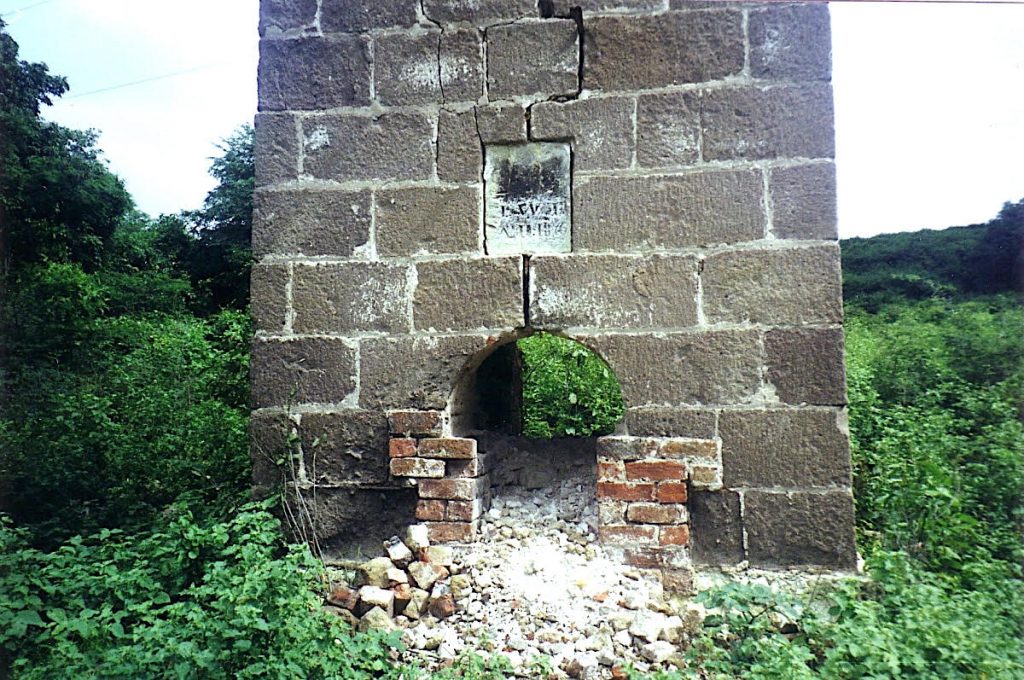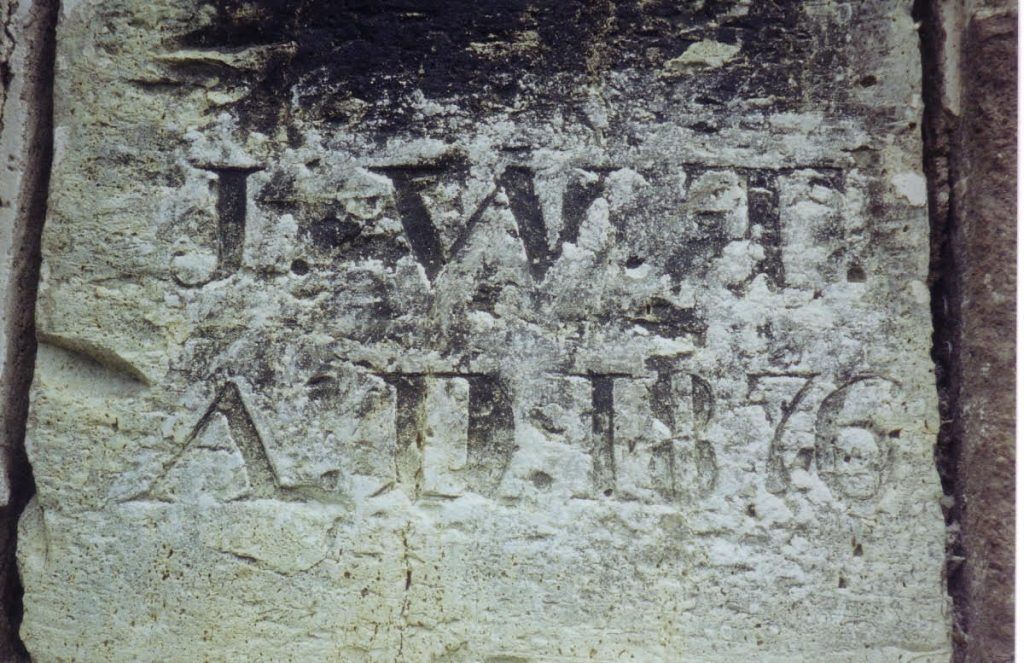About
Type: Ruin
Parish: St.John
Founding date: 1661
See on Google Maps!


Current Status
The sugar mill was converted from wind power to steam in the 1880s. It no longer exists, but a tall, square chimney stands on the site with the inscription “J. W. T. AD 1876” (Jesse W. Thibou). Old machinery from the factory dots the landscape, and on the hill above, there are the remnants of a stone wall which most likely marks the site of the buff house.
Estate Related History/Timeline
Perusing the Ownership Chronology, it is evident that there is some confusion over the shifting ownership of this estate, especially when, in 1780, we knew of at least 12 shares. Estates often were divided as part of the inheritance by large families, most of whom lived abroad as absentee landowners. The estates, whole or partial, were managed by an overseer or resident property manager.
Harvey Keynell’s father was Colonel Christopher Keynell, who accompanied Sir George Ayscough’s fleet to the West Indies in 1651. The Colonel was commissioned by Oliver Cromwell as Governor of Antigua and served from 1653 to 1660. His widow, Joan, married John Hall, who owned Betty’s Hope. Widowed for the second time, Joan fled Antigua during the French occupation for safety in Nevis. She returned in 1668 and repaired the estate’s buildings, but the plantation was taken away from her and given to Colonel Codrington (see #13b – Clare Hall) because it was felt the Briggin’s estate was “too great a quantity of land” for Joan to handle.
It is believed that a Dr. Daniel Mackinen emigrated to Antigua between 1678 and 1688 and may have received grants from King Charles II for the estates Draper’s, Golden Grove (#23), and Dickenson’s Bay (#10 – McKinnon’s). Dr. Mackinen died in 1720 at age 62. An original deed shows that the Golden Grove estate was held from 1678 to 1688 by Colonel Edward Powell, the Deputy Governor of Antigua. Ownership passed to his nephew, Henry Powell, in 1716, who leased the estate to Dr. Mackinen for 99 years.
Vere Oliver, Vol. II.
Mare Seager’s 1/12th ownership, which he passed to Granado Chester in 1782, is typical of the divided estate inheritance described above. Also owning 1/12th was Ann Hodgson Lenaghan and the Reverand James Lenaghan.
The 233 acres of “Little Zoar” in St. John’s Division was bought by Robert Weir in 1704. He already owned Briggin’s and combined the two into a single estate with 426 acres; or the amalgamation was accomplished by Robert Chester, who paid £16,092. 10s. 0p. for 220 acres at £20/acre, including 60 negro men, 52 negro women, 14 boys and 3 girls. Vere Oliver, Vol. I.
An excerpt from the 1743 indenture of Edward Chester reads: “Elizabeth, Mary, and Sarah Carbery grant and convey to Robert Smith in his actual possess being . . . all that boiling house and one-fifth of 24 negro houses standing upon the plantation called ‘Briggins’ in the Parish of St. John’s, Antigua, and all those 10 slaves (names given) and 5 head of horned cattle, 1 ox, 2 cows, and 1 calf and all that undivided fifth of all that windmill . . . .” Vere Oliver, Vol. I.
In 1833, when the British Parliament abolished slavery, the Briggin’s estate was given a Legacy award (Antigua 118) of £731. 55s. 9p. for granting freedom to 49 enslaved. Awardees were Anna Jane Gregory, Elizabeth Gregory, George Murray Gregory, Mary Gregory, and Thomas Smith. The Gregory family members were owners of the estate at that time.
In 1872, Dr. Jesse W. Thibou, MRESE, was a medical officer in St. John’s Parish and a member of the Assembly for St. John’s Division as well as the owner of Briggin’s.
An excerpt from “Symbol of Courage” – Aunty Dood, by Keithlyn Smith, describes a group of people who left Hatton’s and stopped at Briggin’s because they saw empty rooms. They were not aware that if they stayed, they would be required to work without pay. “They turned eastward to Briggin’s Estate one mile and a half way (from Hatton’s Estate). To their surprise, Briggin’s had empty rooms and plenty of it. They decided to rest their heads for a while, but a hard lesson was to be learnt at Briggin’s. That meant that whoever lived there had to work for the estate but would not be paid any.”
Emanuel O. Camacho, who assumed ownership in 1894, was the sole owner of the business A. J. Camaco & Co., an export and merchant business, was founded by his father, Antonio Joseph Camacho. Emanuel owned Briggin’s (#22), Herbert’s (#20), and Dunning’s (#190), presumably inherited from his father. Aubrey J. Camacho had assumed ownership of Briggins in 1878 and by 1881, had amassed ownership of several estates totaling over 2,000 acres.
An 1816 letter from Robert Jefferson to his brother provides interesting insight into the management of a plantation by an absentee landlord: “I have got nothing definite done here yet, I’m sorry to say. Gibson is advancing wages & last week actually bought stock which so far I am glad of as I expect to get a cash settlement from him for our account in some shape or form & this must tend to facilitate it & he has made sundry offers but as yet such vague ones I have not entertained them, but this next week will I do hope bring matters to a close as by Action comes in to force the week after & I fancy Gibson may be brought to terms to prevent proceedings going on — the owners seem to me to care little about matters & have turned him over to battle with me. “Davis is not too clever or too sharp, but he is attentive and looked up to & now that Sheriff has given up business, he is a kind of protege of his & benefits by his advice — he was, in reality, the only man I could get & sharp though Woodcock maybe I have been here long enough to know he is an old scoundrel — He has not one farthing to rub against another, he was a sort of decoy check for Wright in the Bank in his frauds as through his instrumentality the victims were induced to endorse the notes & the other day he endeavored to take me in with some molasses — the man’s appearance is enough for me — Davis wants sticking up to — he is soft & I spoke rather sharply to him only yesterday for ever entertaining one of Gibson’s offers that he should quietly work the Estate & pay our account in three yearly installments the first to begin in November next!!! “The fact is everyone here is so interwoven with each other had I the opportunity of getting a man I own from any of the Islands, I would do so at once — I must, however, battle the watch as I am doing & Nugent still agrees with me it was the most judicious step to bring an action at once as I did whatever turns up — I hope my next will report satisfactorily. An Antiguan Trading Company by Mary Gleadall.
In the 1940s, Briggin’s owner John I. Martin operated a fleet of buses in Antigua, and his son, George, would collect the fares, dropping them into a canvas bag “which he held very tightly.” The bus routes were mostly in Liberta. It was said that Mr. Martin made his money in New York, and when he returned to Antigua, he acquired as much land as possible. At the time, land was very cheap. Selvyn Walter, “Not A Drum Was Heard.“
“John I. and George would come into Royal Bank every week for the money which they put in a big bag. It was said that George could put the money in, but only John I. could take it out. The tellers all received gifts from them at Christmas.” Helen Abbott, Memories of . . . .
What was the Briggin’s estate formerly was the site of the John I. Martin IV Grounds, a drag strip for racing cars. That race track is now located adjacent to Sir Vivian Richard’s Cricket Ground and Lower Cedar Hill.
In 1941, the Antigua Sugar Factory, Ltd., estimated sugar returns from Herbert’s & Briggin’s of 1,060 tons from 1,581 tons of cane delivered, a combination of estate and peasant-worked land.
Enslaved People’s History
Based on contemporary research, we have little information to share about the enslaved peoples from this plantation at this time. They probably had a maximum of 50 people working at that plantation. A fact of interest is that the 233 acres of “Little Zoar” in St. John’s Division were bought by Robert Weir in 1704. He already owned Briggin’s and combined the two into a single estate with 426 acres; or the amalgamation was accomplished by Robert Chester, who paid £16,092. 10s. 0p. for 220 acres at £20/acre, including 60 negro men, 52 negro women, 14 boys and 3 girls. Vere Oliver, Vol. I. An excerpt from the 1743 indenture of Edward Chester reads: “Elizabeth, Mary, and Sarah Carbery grant and convey to Robert Smith in his actual possess being . . . all that boiling house and one-fifth of 24 negro houses standing upon the plantation called ‘Briggins’ in the Parish of St. John’s, Antigua, and all those 10 slaves (names given) and 5 head of horned cattle, 1 ox, 2 cows and 1 calf and all that undivided fifth of all that windmill . . . .” Vere Oliver, Vol. I. In 1833, when the British Parliament abolished slavery, the Briggin’s estate was given a Legacy award (Antigua 118) of £731. 55s. 9p. for granting freedom to 49 enslaved. We will continue our quest for more information about these vital individuals.
Ownership Chronology
- 1661: Captain Harvey Keynell. He was granted 100 acres by the crown, with another 300 acres added in 1676. d. 1681.
- 1678: Colonel Edward Powell, the Governor of Antigua, 1683-1688. The plantation owner until 1688
- 1688: J. Robert Weir
- 1708: Edward Chester (?). May have been the owner until 1743
- 1716: Henry Powell, the Colonel’s nephew
- 1777: Benjamin Ireland, Esq. (1777/78 map by cartographer John Luffman.)
- 1780: Granado Hodgson, plus many shares awarded to heirs through 1828
- 1782: Mare Seager, owned 1/12th of Briggin’s; passed to Granado Chester
- 1790: Benjamin Ireland
- 1828: Ann Hodgson Lenaghan & Reverend James Lenaghan
- 1829: William Gregory 426 acres, 50 slaves
- 1851: Heirs of William Gregory 426 acres
- 1872: Dr. Jesse W. Thibou, MRCSE 440 acres
- 1891: Antonio Joseph Camacho (d.1894) & Emanuel C. Camacho
- 1894: Emanuel Oliver Camacho. Estate reduced to 392 acres
- 1940’s: John I. Martin
- 2003: Heirs of John I. Martin